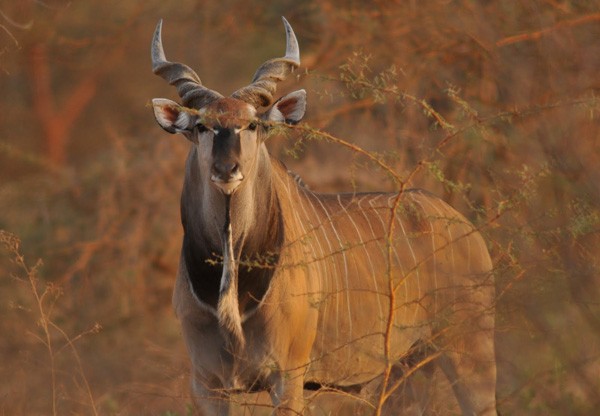Giant eland
A species of Elands, Also known as Lord derby's eland, Western eland Scientific name : Taurotragus derbianus Genus : Elands
Giant eland, A species of Elands
Also known as:
Lord derby's eland, Western eland
Scientific name: Taurotragus derbianus
Genus: Elands
Content
Description General Info
 Photo By Tom Junek , used under CC-BY-SA-3.0 /Cropped and compressed from original
Photo By Tom Junek , used under CC-BY-SA-3.0 /Cropped and compressed from original Description
The giant elands are spiral-horned antelopes. Despite its common name, this species broadly overlaps in size with the common eland (Taurotragus oryx). However, the giant eland is somewhat larger on average than the common eland and is thus the largest species of antelope in the world. They are typically between 220 and 290 cm (7.2 and 9.5 ft) in head-and-body length and stand approximately 130 to 180 cm (4.3 to 5.9 ft) at the shoulder. Giant elands exhibit sexual dimorphism, as males are larger than females. The males weigh 400 to 1,000 kg (880 to 2,200 lb) and females weigh 300 to 600 kg (660 to 1,320 lb). The tail is long, having a dark tuft of hair, and averages 90 cm (35 in) in length. The life expectancy of giant elands is up to 25 years in the wild, and about 20 years in captivity. The smooth coat is reddish-brown to chestnut, usually darker in males than females, with 8–12 well-defined vertical white stripes on the torso. The colour of the male's coat darkens with age. According to zoologist Jakob Bro-Jørgensen, the colour of the male's coat can reflect the levels of androgen, a male hormone, which is highest during rutting. Comparing the subspecies, T. d. derbianus is characterised by 15 body stripes, smaller size, and a rufous colour, while T. d. gigas is larger, a sandy colour, and has 12 body stripes. A crest of short black hair extends down the neck to the middle of the back, and is particularly prominent on the shoulders. The slender legs are slightly lighter on their inner surfaces, with black and white markings just above the hooves. There are large black spots on the upper forelegs. The bridge of the nose is charcoal black, and there is a thin, indistinct tan-coloured line, which is the chevron, between the eyes. The lips are white, as are several dots along the jawline. A pendulous dewlap, larger in males than females, originates from between the jowls and hangs to the upper chest when they reach sexual maturity, with a fringe of hair on its edge. The large ears of the giant eland serve as signaling devices. Giant elands have comparatively longer legs than the common eland, as well as much brighter black and white markings on the legs and pasterns. Both sexes have tightly spiraled, 'V'-shaped horns. They can be up to 123 cm (4.04 ft) long on males and 66 cm (2.17 ft) on females. Males have horns that are thicker at the ends, longer, and more divergent than those of females. These features of the horns suggest that the giant eland evolved from an ancestor with true display horns. 
General Info
Lifespan
15-20 years
Diet
Giant eland's diet primarily consists of grasses and tree leaves. It also feeds on fruits, herbs, and flowers. Although not a strict browser, it selectively consumes shrubs and young shoots as they become available, indicating adaptability in its dietary habits.
Appearance
Giant eland is a large mammal with a sturdy body and short, coarse fur. Its coat is broad-striped in a cream to dull yellow shade with black or dark chocolate-brown. Both sexes possess spiralled horns, the males having thicker and slightly longer ones. Young individuals tend to be lighter in colour with paler stripes.
Behavior
Giant eland beings exhibit gregarious behavior, forming herds of 5 to 60 individuals, led primarily by a mature male. Engaged in a diurnal lifestyle, they forage during the cooler hours of morning and evening, consuming a variety of shrubs and trees. They assert dominance and define territories through spectacular displays involving the clashing of their long horns.